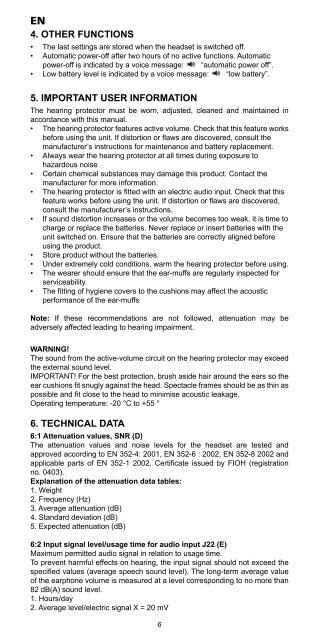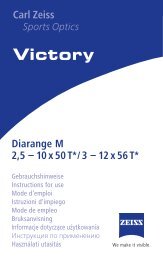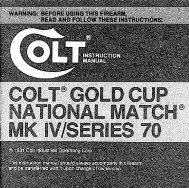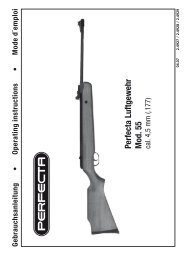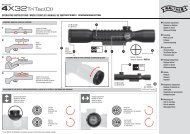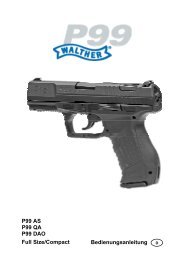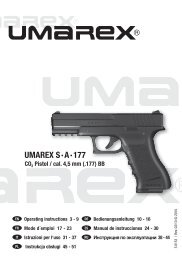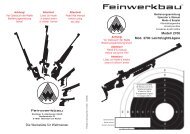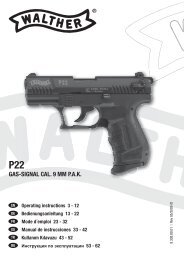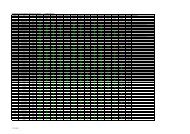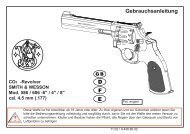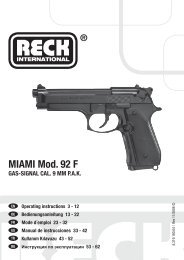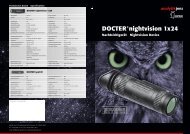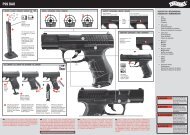WS SportTac, WS5, WS Workstyle - Peltor - 3M
WS SportTac, WS5, WS Workstyle - Peltor - 3M
WS SportTac, WS5, WS Workstyle - Peltor - 3M
You also want an ePaper? Increase the reach of your titles
YUMPU automatically turns print PDFs into web optimized ePapers that Google loves.
EN<br />
4. OTHER FUNCTIONS<br />
• The last settings are stored when the headset is switched off.<br />
• Automatic power-off after two hours of no active functions. Automatic<br />
power-off is indicated by a voice message: “automatic power off”.<br />
• Low battery level is indicated by a voice message: “low battery”.<br />
5. IMPORTANT USER INFORMATION<br />
The hearing protector must be worn, adjusted, cleaned and maintained in<br />
accordance with this manual.<br />
• The hearing protector features active volume. Check that this feature works<br />
before using the unit. If distortion or flaws are discovered, consult the<br />
manufacturer’s instructions for maintenance and battery replacement.<br />
• Always wear the hearing protector at all times during exposure to<br />
hazardous noise<br />
• Certain chemical substances may damage this product. Contact the<br />
manufacturer for more information.<br />
• The hearing protector is fitted with an electric audio input. Check that this<br />
feature works before using the unit. If distortion or flaws are discovered,<br />
consult the manufacturer’s instructions.<br />
• If sound distortion increases or the volume becomes too weak, it is time to<br />
charge or replace the batteries. Never replace or insert batteries with the<br />
unit switched on. Ensure that the batteries are correctly aligned before<br />
using the product.<br />
• Store product without the batteries.<br />
• Under extremely cold conditions, warm the hearing protector before using.<br />
• The wearer should ensure that the ear-muffs are regularly inspected for<br />
serviceability.<br />
• The fitting of hygiene covers to the cushions may affect the acoustic<br />
performance of the ear-muffs<br />
Note: If these recommendations are not followed, attenuation may be<br />
adversely affected leading to hearing impairment.<br />
WARNING!<br />
The sound from the active-volume circuit on the hearing protector may exceed<br />
the external sound level.<br />
IMPORTANT! For the best protection, brush aside hair around the ears so the<br />
ear cushions fit snugly against the head. Spectacle frames should be as thin as<br />
possible and fit close to the head to minimise acoustic leakage.<br />
Operating temperature: -20 °C to +55 °<br />
6. TECHNICAL DATA<br />
6:1 Attenuation values, SNR (D)<br />
The attenuation values and noise levels for the headset are tested and<br />
approved according to EN 352-4: 2001, EN 352-6 : 2002, EN 352-8 2002 and<br />
applicable parts of EN 352-1 2002. Certificate issued by FIOH (registration<br />
no. 0403).<br />
Explanation of the attenuation data tables:<br />
1. Weight<br />
2. Frequency (Hz)<br />
3. Average attenuation (dB)<br />
4. Standard deviation (dB)<br />
5. Expected attenuation (dB)<br />
6:2 Input signal level/usage time for audio input J22 (E)<br />
Maximum permitted audio signal in relation to usage time.<br />
To prevent harmful effects on hearing, the input signal should not exceed the<br />
specified values (average speech sound level). The long-term average value<br />
of the earphone volume is measured at a level corresponding to no more than<br />
82 dB(A) sound level.<br />
1. Hours/day<br />
2. Average level/electric signal X = 20 mV<br />
6


